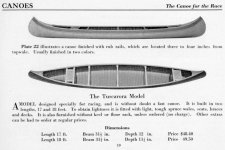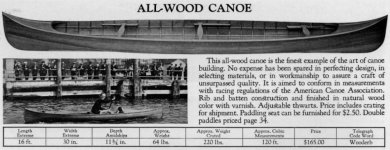It's often said that w/c boats are more pleasing to paddle and it seems so to me. Is it real, or imagined, I was never sure. My first w/c boat was an OT Yankee, it has a flat bottom and probably not a great paddler but I still really liked it. With its' stiff hull and fine entry it was surely better than my royalex boats, especially when heeled over.
After paddling it almost exclusively for a few weeks, then taking the winter off, I paddled my kevlar Malicite the next spring. Wow, this boat paddle real nice too, maybe it's in my head.
Fast forward a few seasons and I got a composite Seliga and really like it. I think it is the most high performance hull I have. My Seliga weighs about 40 lbs. and I wondered how it would compare to the w/c version. If both boats had identical hull shapes what would the difference be? Unfortunately I don't have a w/c Seliga to compare but I do have a theory.
My modern Seliga is just as stiff as any of my w/c boats and if all else is the same, the only difference is weight. I think it is this extra weight that makes the difference. Theoretically both boats should paddle the same, so what difference does the extra weight make. My conclusion was what I refer to as "steadiness." While both boats should have the same stability, the extra weight would make it more steady. For one thing, the extra 30 lbs will make it sit lower in the water making it less twitchy and it should be less affected by the wind. The extra weight may also help with glide.
So, while I don't feel there is much paddling difference between a w/c boat and its composite clone the extra weight gives a more secure (steady) feeling. The question that now remains is there a difference between the two when they are loaded?
To prove this you can take your fine lightweight composite boat and add 30 or 40 pounds and feel the difference.
After paddling it almost exclusively for a few weeks, then taking the winter off, I paddled my kevlar Malicite the next spring. Wow, this boat paddle real nice too, maybe it's in my head.
Fast forward a few seasons and I got a composite Seliga and really like it. I think it is the most high performance hull I have. My Seliga weighs about 40 lbs. and I wondered how it would compare to the w/c version. If both boats had identical hull shapes what would the difference be? Unfortunately I don't have a w/c Seliga to compare but I do have a theory.
My modern Seliga is just as stiff as any of my w/c boats and if all else is the same, the only difference is weight. I think it is this extra weight that makes the difference. Theoretically both boats should paddle the same, so what difference does the extra weight make. My conclusion was what I refer to as "steadiness." While both boats should have the same stability, the extra weight would make it more steady. For one thing, the extra 30 lbs will make it sit lower in the water making it less twitchy and it should be less affected by the wind. The extra weight may also help with glide.
So, while I don't feel there is much paddling difference between a w/c boat and its composite clone the extra weight gives a more secure (steady) feeling. The question that now remains is there a difference between the two when they are loaded?
To prove this you can take your fine lightweight composite boat and add 30 or 40 pounds and feel the difference.
Last edited:


